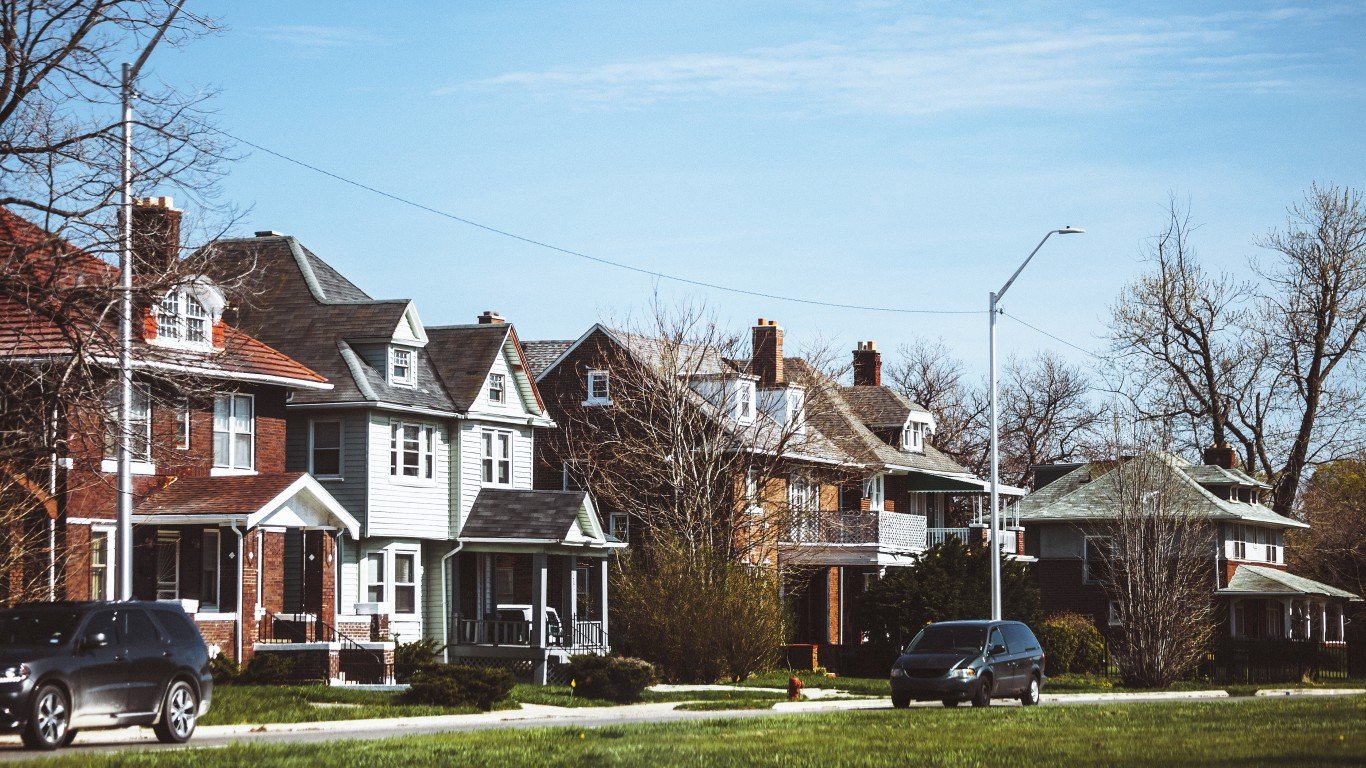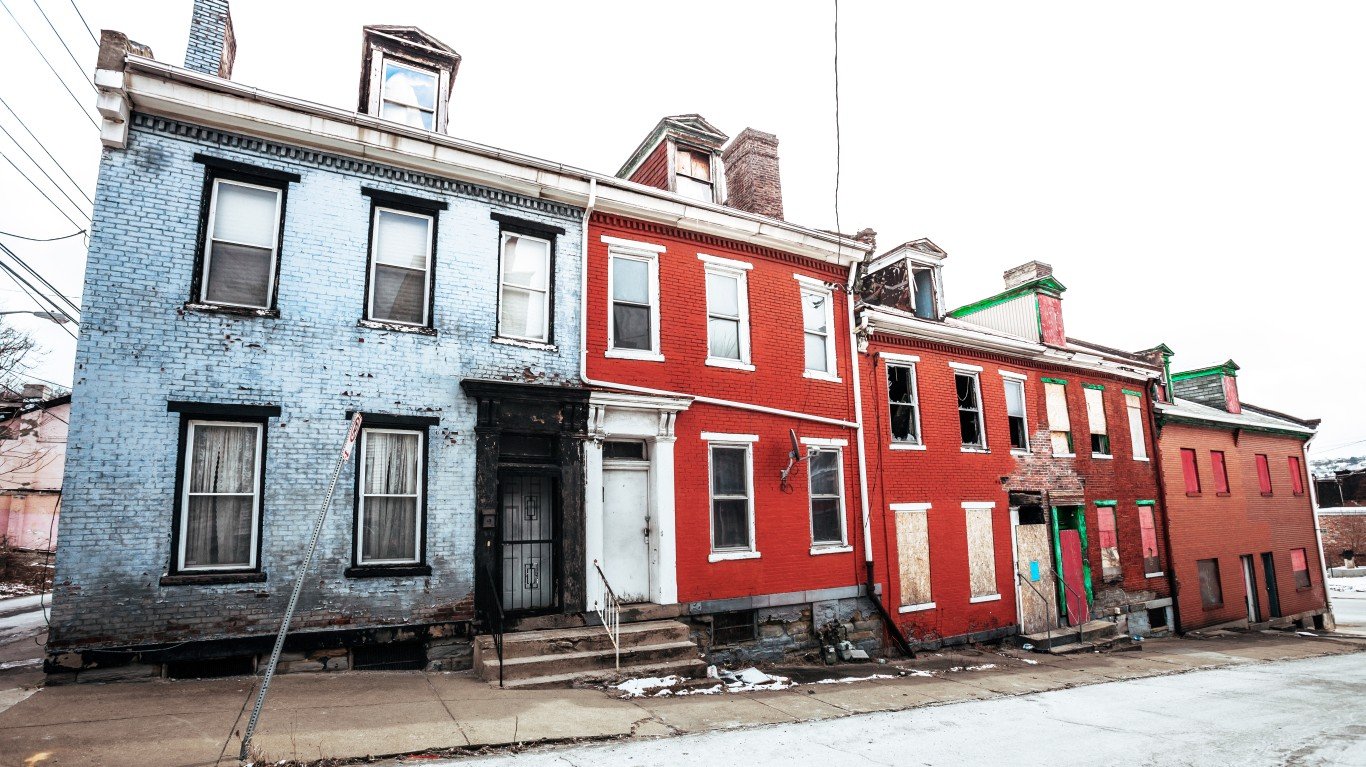 Nationally, home prices are projected to decline 4% by the end of this year, according to Fiserv Case-Shiller’s latest report. Most of the country’s largest metropolitan areas will not escape this fate. In fact, in all but 50 of the 384 metropolitan areas examined, home prices are projected to decline at least through the end of the year before they start improving.
Nationally, home prices are projected to decline 4% by the end of this year, according to Fiserv Case-Shiller’s latest report. Most of the country’s largest metropolitan areas will not escape this fate. In fact, in all but 50 of the 384 metropolitan areas examined, home prices are projected to decline at least through the end of the year before they start improving.
Read the cities where home prices are collapsing.
Read America’s fastest-growing housing markets.
Among the regions where home prices are expected to decrease, only 10 are projected to drop by 7.5% or more, with the largest decrease estimated at 12.2%. 24/7 Wall St. reviewed these 10 areas to identify the reasons behind their falling prices.
In most cases, housing prices in these areas are projected to decrease because the areas are not yet considered good investments. This could be because buyers either do not believe home values have fallen far enough, because of relatively weak local economies, or a combination of the two.
Many of the collapsing housing markets already have experienced significant slumps in home prices. In all 10 of the metropolitan areas, housing prices fell by more than 25% since their prerecession peak. Home prices in seven of the 10 metro areas have plummeted more than 50% since their peak.
Home prices in most of these markets will continue dropping next year too. David Stiff, chief economist at Fiserv Case-Shiller, told 24/7 Wall St. that the nation’s housing recovery is not expected to reach full swing until the end of next year — even in the areas that are currently leading the country in recovery. Nationally, home prices are expected to increase much more in 2013 than in 2012, but not for many of the cities on this list.
In addition to large declines in home prices during the recession, most of the cities with the worst housing markets have unemployment rates higher than the national average. Seven of the cities have unemployment rates above the national rate of 8.3% in February 2012. Half of the cities have unemployment rates above 10%.
Finally, foreclosure processing is another factor that appears to be affecting the recovery in these 10 metros. Housing markets that have been able to resell foreclosed homes have done better than those that have not, Stiff explained. “In California, foreclosures are nonjudicial. They don’t go through the courts, so California is further along in liquidating their foreclosure inventory, whereas foreclosures in Florida,” which are further behind in liquidating foreclosures, “are judicial.” Florida has three housing markets that are on this list.
24/7 Wall St.’s Cities Where Home Prices Are Collapsing is based on Fiserv Case-Shiller’s forecast of changes in home prices from the fourth quarter of 2011 to the fourth quarter of 2012. 24/7 Wall St. also included each metropolitan area’s February 2012 unemployment rate and change in home prices from the fourth quarter of 2010 to the fourth quarter of 2011 — both of which were provided by Fiserv Case-Shiller.
10. Ocean City, N.J.
> Expected price change: -7.5%
> Unemployment rate: 11.6% (25th highest)
> Change in home prices (2010 Q4 to 2011 Q4): -3.1%
Ocean City has been experiencing one of the longest housing downturns in the country, as home prices in the area peaked in the fourth quarter of 2005. Since that time, prices have dropped a total of 27.2%. This trend is expected to continue throughout 2012, during which prices are projected to fall another 7.5%. Home prices eventually will improve in the region, although only slightly compared to the majority of the country. The average annual increase in home prices in Ocean City between the fourth quarter of 2011 and the fourth quarter of 2016 is projected to be 1.6%.
Also Read: Six Cities Where Rents Are Skyrocketing
9. Las Vegas-Paradise, Nev.
> Expected price change: -7.5%
> Unemployment rate: 12.4% (19th highest)
> Change in home prices (2010 Q4 to 2011 Q4): -9.2%
The Las Vegas-Paradise metropolitan area experienced among the greatest real estate growth in the country during first half of the 2000s. Since the beginning of 2006, however, home prices have dropped dramatically, sinking 61.8%. This is the fourth-largest decrease in the nation. The pain is not yet over for Las Vegas, as home prices are projected to drop another 7.5% in 2012. Prices will then drop 3.3% in the following year.
8. Panama City-Lynn Haven-Panama City Beach, Fla.
> Expected price change: -7.7%
> Unemployment rate: 8.3% (141st highest)
> Change in home prices (2010 Q4 to 2011 Q4): -6.8%
Housing prices in the Panama City metro area peaked in the beginning of 2006 and have since dropped 42%. Overall, prices in 2012 are expected to decrease another 7.7%. However, they are expected to begin to rebound in 2013, increasing 1.0% that year. The average annual price increase through 2016 is expected to be 7.6% — among the country’s largest growth rates.
Also Read: The Most Powerful CEOs in America
7. Flagstaff, Ariz.
> Expected price change: -7.7%
> Unemployment rate: 8.3% (146th highest)
> Change in home prices (2010 Q4 to 2011 Q4): -2.0%
Home prices in Flagstaff have dropped nearly 38% since peaking in the second quarter of 2006. The decline recently became less severe, with home prices dropping only 2% in 2011. However, in 2012, home prices will resume their steep descent, falling 7.7%. After this year, the Flagstaff housing market finally is predicted to begin recovering, albeit slowly. Home prices are expected to increase by 1% in 2013.
6. Merced, Calif.
> Expected price change: -7.9%
> Unemployment rate: 17.5% (3rd highest)
> Change in home prices (2010 Q4 to 2011 Q4): -1.9%
Home prices in Merced, Calif., have decreased 69.1% since their peak in the beginning of 2006 — the largest drop in the country. The housing downturn is still getting worse, as prices are projected to fall by another 7.9% in 2012. Prices are expected to increase slightly in 2013, growing an estimated 3.8%. However, the metropolitan area’s economy will still be in rough shape. Merced currently has the third-highest unemployment rate in the country at 17.5%.
5. Cape Coral-Fort Myers, Fla.
> Expected price change: -8.0%
> Unemployment rate: 9.6% (63rd highest)
> Change in home prices (2010 Q4 to 2011 Q4): +3.5%
The Southwest Florida housing market may have the worst long-term outlook in the country, and Cape Coral-Fort Myers is the worst in the area. Home prices in the region have dropped slightly less than 60% following their peak in the first quarter of 2006, one of the country’s most severe downturns. While prices have increased 3.5% in 2011, they are expected to fall by another 8% in 2012 and to continue to drop through 2013. It is not until after that year that the area’s housing market is expected to start turning around.
Also Read: America’s Most (and Least) Peaceful States
4. Riverside-San Bernardino-Ontario, Calif.
> Expected price change: -8.6%
> Unemployment rate: 12.5% (18th highest)
> Change in home prices (2010 Q4 to 2011 Q4): -4.1%
The Riverside-San Bernardino-Ontario metropolitan area, like many other industrial regions in California, has been devastated by the housing crisis. Since the second quarter of 2006, home prices have dropped 56.6% in the region — among the country’s largest drops. The decline let up slightly in 2011, during which prices fell 4.1%. But 2012 is expected to be worse, with prices projected to drop an estimated 8.6%. Prices are expected to continue to fall through 2013. The region also has among the highest unemployment rates in the country of 12.5%.
3. Naples-Marco Island, Fla.
> Expected price change: -9.5%
> Unemployment rate: 8.8% (107th highest)
> Change in home prices (2010 Q4 to 2011 Q4): -0.6%
Until the housing downturn, Naples was one of the fastest-growing housing markets in the country. Much of it was driven by the region’s preparation for the upcoming retirement of the baby boomers. But since peaking in the first quarter of 2006, home prices in the area fell 54.7%. Although prices only dropped 0.6% in 2011, they are forecast to fall another 9.5% in 2012. The following year, they are expected to drop an additional 4.5%. The average annual increase in home prices in Naples projected through 2016 of 1.3% is among the country’s lowest.
Also Read: Thirteen Ways to Sell Your Home in 2012
2. Phoenix-Mesa-Glendale, Ariz.
> Expected price change: -11.1%
> Unemployment rate: 7.7% (184th highest)
> Change in home prices (2010 Q4 to 2011 Q4): -1.2%
Home prices in the Phoenix-Mesa-Glendale metropolitan area have dropped 56% since their peak in the second quarter of 2006. The region also has been plagued by high foreclosure and delinquency rates since that time. In 2011, home prices fell only 1.2%, but this rate is expected to increase significantly to 11.1% in 2012. The trend is projected to reverse in 2013, with home prices increasing 0.4%.
1. Detroit-Livonia-Dearborn, Mich.
> Expected price change: -12.2%
> Unemployment rate: 11.2% (28th highest)
> Change in home prices (2010 Q4 to 2011 Q4): +9.6%
Since the beginning of the recession, the Detroit metropolitan has been among the worst hit in several areas, including home values, foreclosures and unemployment. After home prices in the area peaked in the beginning of 2006, they dropped 55.2%. According to Fiserv’s Stiff, “Detroit is a very volatile market because of the ebb and flow of both foreclosure sales activity and investor demand for properties.” As a result, home prices in the region actually increased 9.6% in 2011 — the largest amount in the country. For 2012, however, prices are expected to dive once again, dropping 12.2%. This is largely the result of the weak local economy and the high volume of foreclosure and short sales.
Charles B. Stockdale
Sponsored: Find a Qualified Financial Advisor
Finding a qualified financial advisor doesn’t have to be hard. SmartAsset’s free tool matches you with up to 3 fiduciary financial advisors in your area in 5 minutes. Each advisor has been vetted by SmartAsset and is held to a fiduciary standard to act in your best interests. If you’re ready to be matched with local advisors that can help you achieve your financial goals, get started now.
Thank you for reading! Have some feedback for us?
Contact the 24/7 Wall St. editorial team.



